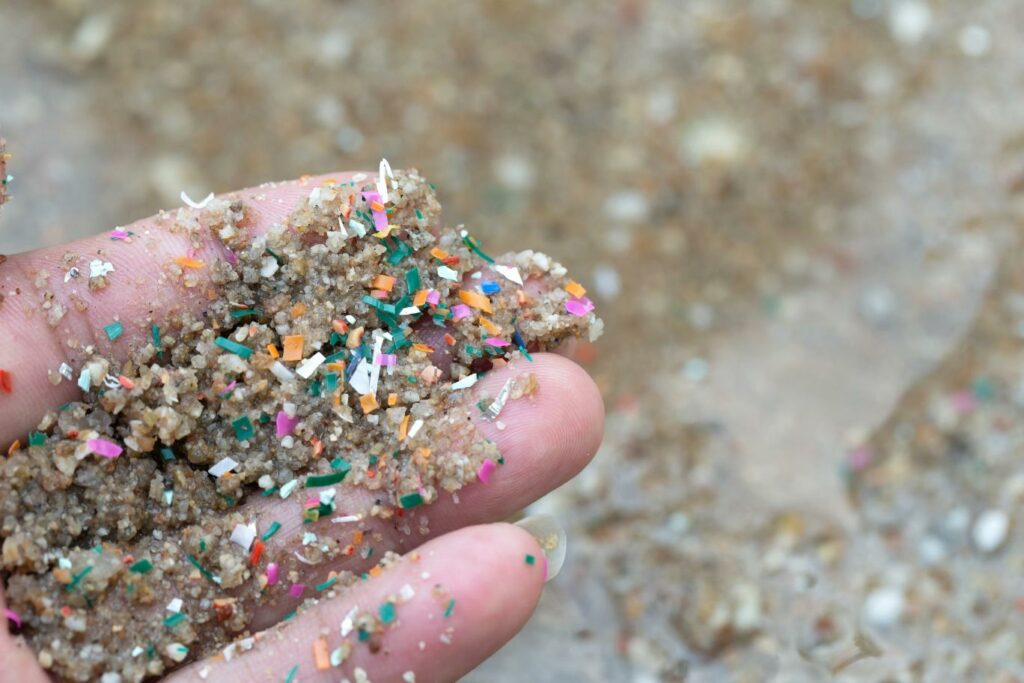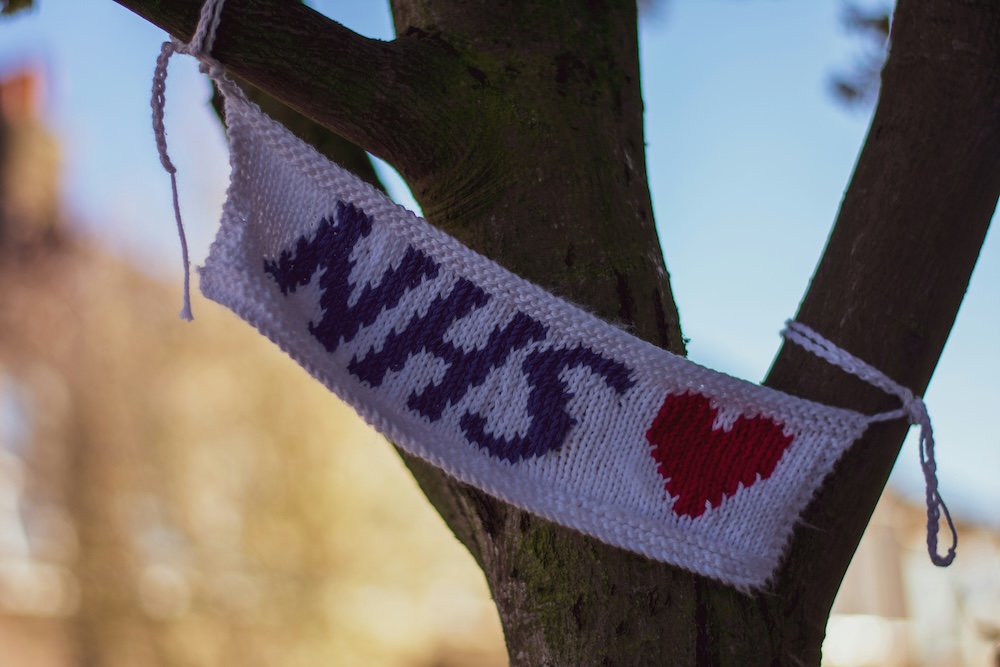Present in our oceans and soils, microplastics are a harmful and pervasive phenomenon. But what can be done in Wales? Kirsty Luff investigates.
I didn’t think about microplastics much until a team away day last February. We were gathered around a table, dotted with petri dishes full of sand or soil and taking it in turns to look at the microplastics.
When I donned the bright orange spectacles and shone a UV torch at a sample from Broadhaven beach in Pembrokeshire, the clear yellow sand transformed into a galaxy of shining stars. Red, yellow, and orange glittery blobs were occasionally punctuated by a long thread.
Ever since, I’ve been on a mission to find out more about this insidious and largely invisible kind of pollution.
What are microplastics?
Microplastics are particles smaller than 5mm and larger than 1 micron (1/1000th of a millimetre) in length. For comparison, 5mm is the same as small grain of rice, whereas 1 micron is the size of dust mite particles, mould spores, and bacteria. Microplastics between 1 and 2.5 microns are especially dangerous to human beings. These airborne particles are small enough to be inhaled, and can potentially cause health problems.
Just over a third of microplastics in our seas and oceans are microfibres, shed when we wash nylon and polyester clothing.
The enormous great Pacific Garbage Patch shows how much our oceans are being used as our rubbish dump. More than 430 million tons of plastic is produced annually. Most of this is single use plastic like bags, bottles, and wet wipes, some of which end up in the sea and then break down into smaller and smaller pieces.
Just over a third of microplastics in our seas and oceans are microfibres, shed when we wash nylon and polyester clothing. As part of Sustainable Clothing and Textiles Cymru coalition, Friends of the Earth Cymru is calling on the Welsh Government to take more action to address the growing problem of microplastics.
Where are microplastics found?
Although we can’t always see them, microplastics are everywhere, from our busiest towns and cities to our deepest oceans. These tiny, microscopic particles have even been found inside our own bodies.
According to a 2020 article in Case Studies in Chemical and Environmental Engineering by Roisin Coyle, Gary Hardiman and Kieran O’ Driscoll, ‘estimates suggest that 92% of the 5.25 trillion plastic particles on the ocean surface are microplastics.’ A study from the University of Portsmouth last year found there was 100 times more microplastics on UK coasts than the six years ago.
Our rivers fare no better. Research by Bangor University and Friends of the Earth in 2019 discovered microplastics in some of Wales’s most iconic and remote rivers and lakes including Llyn Cefni Reservoir in Anglesey and Afon Cegin, a river in North Wales. According to a survey of the river Mersey near Liverpool, there were an average of 84,030 particles of microplastics in each square of water.
Citizen science
It’s clear to me, even as a lay person, that as a nation we should be monitoring for microplastics, as we do for air pollution. Until then, however, citizen science must fill the gap.
Innovative. Informed. Independent.
Your support can help us make Wales better.
I’ve been helping Friends of the Earth local action groups to test soil and sand in their local area, using a microplastics test kit purchased from the Young Darwinian, which uses Red Nile Dye to stain the sample to make the microplastics more visible and easier to count.
In September 2022, Pontypridd Friends of the Earth tested the soil in their local area using the kit. The group counted over 80 microplastics in a teaspoon of soil from the bank of the river Rhondda. In contrast, they found barely any in a mole hill, 10 in soil dug up by the dog, and 11 in garden soil!
Other Friends of the Earth local action groups are also testing for microplastics, and we look forward to seeing their results – check the foe.cymru website for updates!
How do microplastics affect us?
Unfortunately, growing evidence indicates that ingesting microplastics is damaging the health and biodiversity of life in our oceans and waterways.
Until recently, most research on microplastics has focused on its effects on fish and other aquatic life, with evidence that microplastics are causing inflammation, reduced fecundity and other adverse effects for fish, crustaceans and plankton. But in the last few years, scientists have started to investigate their impact on the health of terrestrial animals. The results are worrying. Recent studies reveal that microplastics may also cause biochemical and structural damage to the intestine, liver, and reproductive systems of laboratory mice and rats.
The Welsh Government has already introduced legislation to curb our use of plastic, which, in time, should have an impact on the amount of microplastics in our environment.
In 2022, scientists discovered microplastics in the blood of human beings for the first time, demonstrating that ‘particles can travel around the body and may lodge in organs’. Microplastics have also been found to damage human cells when studied in laboratory conditions.
The impact on our health remains unclear but that could change rapidly as studies are coming out all the time. As the website Earth.org says, ‘in recent years, microplastics have been appearing in news headlines with the same creeping ubiquity with which they permeate our everyday lives and the natural world’. For instance, in December 2023, a study showed that nanoplastics could increase the risk of Parkinson’s Disease.
What can we do?
There are things we can do, as individuals, to help, like avoiding single use plastic and switching to reusable containers. We can choose clothes made from natural and sustainable materials such as wool and cotton. If we have the money, we can buy our own washing machine filter to stop microfibres from our synthetic clothes being released into the environment or buy a filter for our tap, so we don’t drink water with microplastics in it.
For my own part, as well as trying to avoid single use plastic, I am looking into getting a filter for my own washing machine and have started looking at the labels when buying clothes.
But we can’t just rely on the action of individuals, we need government action.
The Welsh Government has already introduced legislation to curb our use of plastic, which, in time, should have an impact on the amount of microplastics in our environment. For instance, the Environmental Protection (Single-use Plastic Products) (Wales) Act 2023 bans a range of single-use plastics such as polystyrene cups, food containers, cotton buds, plastic cutlery and plates, beverage stirrers, straws, and balloon sticks. They are also working with the UK and devolved governments to introduce a Deposit Return Scheme for drinks containers and a British Standard to prevent plastic pellets leaking into the environment when plastics are produced and transported.
In 2017 the Welsh Government also banned microbeads, ‘water-insoluble solid plastic particle of up to 5mm in size, too small to be filtered out in sewage treatment systems’.
It’s great that steps like these have been taken and that other actions are in the pipeline. The question is whether it is enough.
In view of the likely impact on ecosystems and our own health, we believe microplastics should be dealt with separately by the Welsh Government, and not from within the wider category of plastics. That would focus our efforts and ensure we are doing all we can to address this problem.
What more can Welsh Government do?
Sustainable Clothing and Textiles Cymru are calling on Welsh Government to bring together a panel of experts to draw up a new Microplastics Action Plan for Wales. It’s vital that experts co-devise this strategy and the solutions in a steering or working group.
As I have mentioned before, there are more things Welsh Government could do to tackle the growing issue of microplastics, like regularly testing different environments for microplastics. If we don’t do this, how do we know the scale of the problem we are dealing with, and if our interventions are effective? Testing may also help indicate sources and solutions and inform the way ahead. Now that we know dirty air poses a risk to our health, national air quality monitoring is in place. Alarmingly, microplastics can be inhaled like other forms of particulate matter, and emerging evidence suggests it is damaging to health.
Another thing Welsh Government could do is put pressure on the UK Government to introduce legislation to ensure all new washing machines have filters to stop microplastics being released into the environment. In France all new washing machines must include this filter from 2025.
In general, the EU seem to be willing to take more action than us on microplastics. In April 2023 the Netherlands, Austria, Belgium, and Sweden called for an ambitious new law ‘to prevent microplastics pollution clogging up the environment’. Later that year the European Commission introduced new rules to ‘restrict microplastics intentionally being added to products that would prevent half a million tonnes of microplastics being released’.
The past few years have seen an explosion of research into microplastics, and this growing scientific interest is likely to continue. We could see a huge tidal wave of public concern break as we find out more, through the drip drip of shocking media headlines about how damaging microplastics are to us and the precious nature around us. Wales prides itself on its environmental credentials, so isn’t it right we show leadership in this area? Because now is the time to act. Not when the wave has broken.
All articles published on the welsh agenda are subject to IWA’s disclaimer. If you want to support our work tackling Wales’ key challenges, consider becoming a member.





